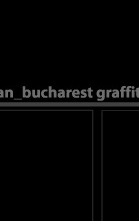In the writings on international graffiti's history
and theory there appear a lot of writers' and artists' names. There are names
that sound more like nicknames - strange, dubious, smart, with an echo, persisting
in memory. Stucking to your brains. Some of this calligraphers (however not
so much the female calligraphers) are even the subject of monographical studies.
A 30 years history of continous writing provoked curiosity and challenge,
indifference or fanatism, cherishing or despise, passions and hatreds. That,
of course, where there is a 30 years history or at least a 10 years one. Everywhere,
however, even where graffiti appeared suddenly, as an imported virus, there
have been polemics around the unconventional images on the walls. I use these
terms as I find them most appropriate in order to depict the nature of dialogues
- more silenced or more hysterical, more reasonable or really scientific -
determined by the appearance in the public space of writings or drawings with
a permanent character (as permanent as the wall or the glass support allows).
A quick overview of the texts - critical theory, opinions or confessions of
the authors - is enough for one to get an idea and a general image upon this
phenomenon in the contemporary world: it is to be noticed the frequency of
the word WAR. The battle seems to take place between the intransigents - those
who assume a so-called graffiti ethics, originated in the 70's in New York,
that they want to keep without compromises; on the other hand, "the good
guys" - the public authorities, the respectable citizens and the "nice"
and well-educated graphers who express their talent on canvases elegantly
exhibited in art galleries or who are sketching on the virtual walls on the
Internet. The war looks like a world war. The spectators are numerous and
amongst them there are some who are for and others against; and there are
others who are only assisting.
Sociology, urban anthropology, history, art history, literary or art criticism
and theory collect, provide, build and support the foundations of a theory
pro-graffiti. Although this pro- direction is not too obvious, I think it's
in any case positive.
Graffiti assumes a tradition of more than 5000 years. A genealogical tree
has been conceived (that is all the time mentioned in the texts, as a justification),
containing also Napoleon Bonaparte, who has written his own name on the top
of Keops' pyramid in 1797.
It was more an utilitary necessity rather than a cerebral one that gave birth
to pro-graffiti literature: writing in public space is considered a penal
crime and it's taughly punished with jail to 4 years.
In Romania, at the end of November 2003, there has been a lot of noise around
an inscription with political message from a public statue in Timisoara. The
press declared itself irritated and overread that message, considering it
an attack to public safety and public statuary patrimony. It was for the first
time that the Romanian press had an attitude vis-à-vis graffiti. And
the reason for doing it was the lack of a different subject for news. As Bucharest,
since about 3 months, is crowded with inscriptions much more direct: in June,
on the route of the bus 601, from Universitate to Grozavesti, there appeared
on all the walls a bloody message (as it was written with red paint): (ISUS
VINE) JESUS IS COMING. Then it was conquered the route of the buses 133, 79,
86, 92, 70 - from Piata Rosetti to Foisorul de Foc, with the same message.
Cismigiu park also. And I believe now it's almost everywhere. The only replica
in press for these inscriptions was that of a reporter from Academia Catavencu,
who thought about writing himself, with green, JESUS IS LEAVING. The comentaries
were indeed unnecessary.
But graffiti in Bucharest is an imported pill. Came with the rockers' wave,
more comfortably accomodated by the rappers. And now again, since a few months
the walls "began to talk" more firmly. Smarter. More ingenious.
More ironic. More cinical and more tough. Graffiti begin to become a serious
phenomenon. And, in fact, intervention in public space becomes more serious.
You ecounter them with surprise, with pleasure, they relaxe you in your need
of revolt that you don't know how to exteriorize. You begin to understand
that it's something premeditated, logically projected, and that the strategy
is taking into consideration all the streets' network of Bucharest, and not
a special neighbourhood or spot. And you begin to understand that they do
not address to the walls, or the fences, which are supports to be seen by
everybody, by the people. And you begin to understand that you are one of
the targets too. That they do not appear overnight from some kind of boring,
but they think about you. And, whether you like it or not you have them in
front of your eyes. They are accompanying you wherever you go, like the Jesus
who is announced.
Between the Connex block of flats and Octavian Goga bus station, there is
an empty area, surrounded by a wall. It is over crowded with inscriptions
and drawings. And the inscriptions are not dry messages or religiously perplex,
nor impossible and undecipherable fat letters that you can find all over the
place, but firm messages, positive, extremely actual. They are a sort of pacific
sayings, still some more than just big words thrown to the wind, for you can
sense their power and you perceive them personally.
Urban sociology and anthropology sustain that graffiti is communication. An
obviously direct communication, as it uses codes, slangs, unconventional formulae.
Due to the fact that it follows the code of an ethics of revolt, that it settles
itself into non-conformism and illegality, the fact that the author is certainly
a disident - as he/ she uses the city's walls - the message does not flow
into abstract, does not remain suspended but addresses with precision to some.
There are no signatures on this wall. In fact, I've never seen signatures
in Bucharest. The authors are anonymous and I think it's very clear their
intention of staying anonymous. The guy who puts everywhere drawings made
in a pattern - or inscriprions (again with a pattern) - does not stop hitting
the surprised and worried eye. The great project of intervention - for it
is great -, sometimes sharp and merciless, sometimes out of the Bucharest
context, seems to be only at the beginning. And it proceeds out of it a certain
nerve that irritates the contemporary art critics, who sound something like
"show yourself Mr. Artist, come out of your anonymity so that we can
celebrate you and that we can dedicate you monographical studies because you
gave us graffiti-art, and now we are like we should be".
"Subway Art" is also called the "Holy Book" or "Graffiti Bible". It is written by an expert in the art of street inscriptions and it is addressed mostly to those aspiring to become writers. Here there are depicted the initiation techniques, the important steps, the trials, the dangers. It's also depicted the hierarchy of the graff community and it's an absolute law the adopting and continuing of tradition. The apprentice looses his/ her right of becoming a recognized writer if he/ she is not endowed and strong and cinical enough to create a style of his/ her own, to take a nickname with impact, if he/ she does not respect the professional deontology of the writers making compromises or not resisting to the authorities' or police's pressures. We find here a code of the perfect writer and a promise of celebrity and respectability inside the community and outside/ against the system. A theoretical issue is also brought to consideration: the faith confession of the writer must be assumed under any circumstances, even that of having to give up celebrity and public acknowledgement. Graffiti means rebellion, inquietude, disident attitude, non-conformism, sacrifice for and in the name of communication and of self-expressing in the terms of a positive message. The writer has to approve and to continue the battle against the system, to act in the name of the right to communicate, to his/her self-expression and that of the close people, to plead for everyone's right to enjoy the public space, no matter how an individual understands to use it, to prove that strong personalities can exist outside the system.
I was disappointed by the baseless gesture of a gallerist
who was telling, full of himself, to a young group of the top art theorists,
about the author of a great and ingenous intervention in the urban Bucharest
landscape. The gallerist was trying to buy some celebrity in those moments,
underlying his own contribution to the concept and the development of the
project. An anonymous action at first, the project aimed at introducing a
small pink accident, absolutely harmless, on the walls of the buildings: it
was a 10 cm cocoon, with a human face. Something that had to raise questions
and to provoke a certain type of communication - and that has really happened.
The Art University building was also included in the network - as it is included
also by the author of the patterns. A quite ironical gesture, I believe. And
if Gorzo disclosed himself - his coming out of anonymity being welcomed with
official applauses, that doesn't mean that his name changed in any way or
interfered with the target of the intervention.
I'm thinking more and more and I believe that everything takes us to the same
thing, that Michel Foucault said 30 years ago: "It doesn't matter who's
talking, the important thing is what it's being said". The streets, the
walls, are speaking about something very precise, extremely present and therefore
very painful. I'm not speaking in vain, as a proof the fact that the writings
and drawings in Bucharest appear more often, more visible, all around under
your eyes. They appear overnight so as you can better swallow their message
in the morning and that you know what you think and how the others think.
Ina Cazan
|
|
|
||||||||||||||||||||||||||||||
|
|
 |
|
 |
|
|
||||||||||||||||||||||||||
|
|
 |
 |
|
||||||||||||||||||||||||||||
|
|
 |
 |
|
||||||||||||||||||||||||||||
|
|
 |
|
|
||||||||||||||||||||||||||||
|
|
|
||||||||||||||||||||||||||||||
|
|
 |
|
|
|
|||||||||||||||||||||||||||
 |
 |
|
|
||||||||||||||||||||||||||||
|
|
|
 |
|
||||||||||||||||||||||||||||
|
|
|
||||||||||||||||||||||||||||||
|
|
 |
|
|
||||||||||||||||||||||||||||
|
|
 |
|
 |
 |
 |
|
|||||||||||||||||||||||||
|
|
 |
|
|
||||||||||||||||||||||||||||
|
|
|
|
|
||||||||||||||||||||||||||||
|
|
|
||||||||||||||||||||||||||||||
| |
|
||||||||||||||||||||||||||||||
 |
|
||||||||||||||||||||||||||||||
|
|
|
|
|||||||||||||||||||||||||||||
 |
|
|
|||||||||||||||||||||||||||||
|
|
 |
 |
|
||||||||||||||||||||||||||||
 |
 |
 |
|
||||||||||||||||||||||||||||
 |
|
||||||||||||||||||||||||||||||
 |
 |
|
|
||||||||||||||||||||||||||||
 |
|
||||||||||||||||||||||||||||||
|
|
|
||||||||||||||||||||||||||||||
|
|
|
|
|
|
|
|
|
|
|
|
|
|
|
|
|
|
|
|
|
|
|
|
|
|
|
|
|
|
|
|
|